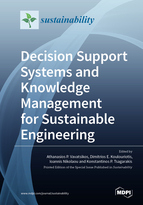Decision Support Systems and Knowledge Management for Sustainable Engineering
A special issue of Sustainability (ISSN 2071-1050). This special issue belongs to the section "Sustainable Engineering and Science".
Deadline for manuscript submissions: closed (31 March 2020) | Viewed by 82796
Special Issue Editors
Interests: decision support systems, decision modeling, multicriteria decision analysis, geographical information systems, capital investments evaluation, project management
Interests: intelligent systems; computational intelligence and cognitive engineering; data analytics and knowledge engineering; decision support systems, production and logistics engineering and management; engineering and project management, optimization, safety-risk and reliability engineering and management; total quality management and business excellence; innovation and technology management; patents; standardization, corporate social responsibility; international standards organization; global reporting initiative
Special Issues, Collections and Topics in MDPI journals
Interests: corporate environmental management; corporate sustainability; corporate social responsibility; business circular economy models; environmental economics
Special Issues, Collections and Topics in MDPI journals
Interests: circular economy; technical–economic project evaluation; environmental and energy economics; environmental and energy behavior; environmental performance of firms; quantitative methods
Special Issues, Collections and Topics in MDPI journals
Special Issue Information
Dear Colleagues,
Modern engineering approaches focus on the design and operation of systems and products in a way that allows for the sustainable use of resources. Sustainable engineering aims to provide frameworks that ensure development without compromising the quality of the natural environment and the ability of future generations to meet their own needs. In that context, decision making processes must be enriched by approaches and tools that allow decision makers to consider a wide range of sustainable options.
Since the publication of the United Nations Sustainable Development Goals (SDGs) many international and national organizations have published strategies for achieving sustainability, some of which have already been implemented. Meanwhile, also the international standardization bodies, IEC (International Electrotechnical Commission), ISO (International Organization for Standardization), and ITU (International Telecommunication Union) have published strategy papers or even videos on their efforts to meet the SDGs. For example, IEC work directly impacts 12 of the 17 SDGs. For each goal ISO has identified the standards that make the most significant contribution. Moreover, according to ITU information and communication technologies (ICTs) are the main enablers that will accelerate the achievement of all SDGs. However, the academic and scientific debate on the contribution of standardization to sustainability is still in its infancy. So far, it focuses particularly on the role of standardization for life cycle assessment and in supply chains. New developments, like digitalization and artificial intelligence, require both standards, but might also have a strong impact on sustainability. However, the scientific community has not yet addressed these complex interactions in-depth. For a more critical assessment of the strategies of the international standardization bodies, but also to provide a sound scientific base to derive recommendations for their improvement, research and evidence-based insights are needed. Here, big data and new data sources provided by the Internet and social media networks, like those investigated within the European Horizon 2020 project EURITO, might help to provide the data base to investigate the new challenging questions about the relationship between sustainability and standardization.
Recently, great progress is taking place in the fields of operation research and management science, where intelligent quantitative analysis, statistics, and prediction analytics are employed in a variety of interdisciplinary research areas, aiming to assist policy makers and managers with the consideration of a variety of sustainable options.
This Special Issue welcomes contributions on theory, methods, and applications, as well as case studies coming from cross-discipline aspects of sustainable engineering, economics, production, energy, and the environment. The Special Issue will be a reference for the way in which a variety of quantitative approaches can assist the design, planning, and evaluation of candidate sustainable options and strategies.
Assist. Prof. Athanasios P. Vavatsikos
Prof. Dimitrios E. Koulouriotis
Assoc. Prof. Ioannis Nikolaou
Prof. Konstantinos P. Tsagarakis
Guest Editors
Manuscript Submission Information
Manuscripts should be submitted online at www.mdpi.com by registering and logging in to this website. Once you are registered, click here to go to the submission form. Manuscripts can be submitted until the deadline. All submissions that pass pre-check are peer-reviewed. Accepted papers will be published continuously in the journal (as soon as accepted) and will be listed together on the special issue website. Research articles, review articles as well as short communications are invited. For planned papers, a title and short abstract (about 100 words) can be sent to the Editorial Office for announcement on this website.
Submitted manuscripts should not have been published previously, nor be under consideration for publication elsewhere (except conference proceedings papers). All manuscripts are thoroughly refereed through a single-blind peer-review process. A guide for authors and other relevant information for submission of manuscripts is available on the Instructions for Authors page. Sustainability is an international peer-reviewed open access semimonthly journal published by MDPI.
Please visit the Instructions for Authors page before submitting a manuscript. The Article Processing Charge (APC) for publication in this open access journal is 2400 CHF (Swiss Francs). Submitted papers should be well formatted and use good English. Authors may use MDPI's English editing service prior to publication or during author revisions.
Keywords
- Capital investments—project financial evaluation
- Circular economy, green entrepreneurship, and consumption
- Corporate social responsibility and business ethics
- Energy engineering and management
- Environmental marketing and management
- Green intellectual capital and business management
- Green logistics
- Industrial ecology
- Knowledge management
- Operations research methods and applications
- Project economics and risk management
- Sustainable engineering innovation and entrepreneurship









